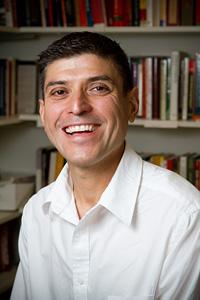November 10, 2010
Rick A. López ’93, an associate professor of history at Amherst, is the author of Crafting Mexico: Intellectuals, Artisans, and the State after the Revolution (Duke University Press). In this new book, scheduled for release on Nov. 11, 2010, López explores how, after Mexico’s revolution of 1910–1920, its artists and intellectuals used dance, music and handicrafts to formulate a unified cultural identity for the Mexican people and to symbolize the nation’s modernity. Lopez will appear in the Mead Art Museum to discuss and sign his book on Nov. 17 from 4:30 to 5:30 p.m.

In Crafting Mexico, López discusses the work of painter Diego Rivera, educator Moisés Sáenz, composer Carlos Chávez, anthropologist Manuel Gamio and many lesser-known Mexican thinkers and artists. He examines how Mexican nationalist efforts intersected with transnational intellectual and artistic trends and how these efforts were adopted and adapted by rural communities. He devotes three of the book’s eight chapters to an in-depth account of artisanal practices in the village of Olinalá, in the mountainous southern state of Guerrero. The book features numerous color and black-and-white illustrations.
Gilbert M. Joseph, co-editor of Fragments of a Golden Age: The Politics of Culture in Mexico since 1940, writes of Crafting Mexico, “Better than any study I know, it wrestles with the complex process whereby Mexico transformed itself from a fragmented society, driven by regional loyalties, linguistic and cultural particularism, and caudillo politics, into one of the hemisphere’s most unified nations.”
López’s research for the book involved living in Mexico—in both Mexico City and Olinalá—from 1997 to 1999. “One of the things that I enjoyed during this book project was the freedom to be very interdisciplinary while still staying very grounded in historical methods,” the author says. “Most art historians that I was working with assumed I was an art historian, anthropologists thought I was an anthropologist, and historians knew that I was a historian—so I got to play different roles as I connected into different intellectual communities in Mexico and in the U.S.” The book grew out of López’s Ph.D. dissertation at Yale, and it wasn’t until he was nearly done with the project, he says, that he realized its thematic similarity to the senior thesis he did at Amherst, about the development of a particular aesthetic in Chicano art in Northern California. (He double-majored in history and fine arts at Amherst; the thesis was for the Fine Arts Department, now called the Department of Art and the History of Art.)
At Amherst, López now teaches about Latin American art, culture and politics; environmental history; popular movements; indigenous political identity; race, gender and identity; fascism; and the U.S.-Mexican borderland (where he himself grew up). He is the author of many articles and book reviews and a co-editor of the 2003 book Moviendo Montañas: Transformando la Geografía del Poder en el Sur de México (Colegio de Guerrero). He is also currently at work on two more manuscripts.